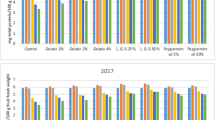Abstract
Date palm (Phoenix dactylifera) is widely cultivated in Kutch district of Gujarat and the fruits are harvested at immature stage before the onset of monsoon to prevent spoilage. The immature date fruits with less commercial value were used for processing into date juice concentrate. Immature dates were crushed and treated with 0.1% pectinase enzyme for 120 min to obtain maximum juice. Date juice was found to be rich in reducing sugars (16.1%) and total sugars (18.3%). Juice was pasteurized at 85°C to inactivate the enzyme, cooled and centrifuged at 3000 rpm to get clear juice. The juice was concentrated in a thin film evaporator to a total soluble solids (TSS) of 76°Brix in 2 passes. Chemical composition of date juice during different stages of concentration was determined. Date juice concentrate was packed in low density polyethylene bags of size (22 cm × 14 cm) and frozen in blast freezer at −40°C and stored at −20°C. Storage of date juice concentrate at −20°C for 6 months indicated no significant changes in TSS, acidity, ascorbic acid, total sugars and pH. Hunter colour lightness L, and redness a values of date juice concentrate decreased whereas b values increased during storage. Date juice concentrate was stable during 6 months storage could be reconstituted for preparing ready-to-serve beverages with acceptable sensory quality.
Similar content being viewed by others
References
Al-Hooti S, Sidhu JS, Al-Otaib J, Al-Ameeri H, Qabazard H (1997a) Date bars fortified with almonds, Sesame seeds, oat flakes and skim milk. Pl Food Human Nutr 51:125–135
Al-Hooti S, Sidhu JS, Al-Otaib J, Al-Ameeri H, Qabazard H (1997b) Utilization of date fruits at different maturity stages for variety pickles. Advn Food Sci 19:1–7
Al-Hooti S, Sidhu JS, Al-Otaib J, Al-Ameeri H, Qabazard H (1997c) Processing of some important date cultivars grown in United Arab Emirates into chutny and relish. J Food Proc Presrv 21:55–58
Amerine MA, Pangborn RM, Roesser EB (1965) Principals of sensory evaluation of food. Academic Press, London, p 5
AOAC (2000) Official methods of analysis, 17th edn, Association of Official Analytical Chemists, Maryland, USA
Bolin HR, Salunkhe DK (1971) Physico-chemical and volatile flavour changes occurring in fruit juices during concentration and foam mat drying. J Food Sci 36:665–668
Demeczky M, Khell-Micklein M, Godek-Kerch E (1981) The preparation of fruit juice semi concentrates by reverse osmosis. In: Developments in food preservation — 1. Stuart Thorne Applied Science Publ, London, p 93–119
Floribeth V, Celsa L, Cooke RD (1981) A study of the production and clarified banana juice using pectinolytic enzymes. J Food Technol 16:115–125
Hunter S (1975) The measurement of appearance. John Wiley and Sons, New York, p 304–305
Khamrus K, Pal D (2002) Application of reverse osmosis for concentration of Kinnow mandarin juice. J Food Sci Technol 39:310–312
Kulkarni SG, Vijayanand P, Aksha M, reena P, Ramana KVR (2008) Effect of dehydration on the quality and storage of immature dates (Pheonix dactylifera). LWT Food Sci Technol 41:278–283
Medeni Maskan (2006) Production of pomegranate juice concentrate by vacuum heating methods: colour degradation and kinetics. J Food Eng 72:218–224
Ranganna S (1986) Hand book of analysis and quality control for fruit and vegetable products. 2nd edn, McGraw Hill Publ Co. Ltd., New Delhi, p 12–16, 83–88
Sandhu KS, Bhatia BS, Shukla FC (1985) Physico-chemical changes during storage of Kinow mandarine oranges and pineapple juice concentrate. J Food Sci Technol 22:342–345
Steel RGD, Torrie JH (1980) Principles and procedures of statistics. Mc Graw — Hill, New York
Thakur NK, Lal Kaushal BB, Joshi VK (2000) Effect of different conditions of storage on physico-chemical and microbiological qualities of debittered kinnow juice concentrate J Food Sci Technol 37:415–418
Vayalil PK (2002) Antioxidant and antimutagenic properties of aqueous extract of date fruit (Phoenix dactylifera L. Arecaceae). J Agric Food Chem 50:610–617
Author information
Authors and Affiliations
Corresponding author
Rights and permissions
About this article
Cite this article
Kulkarni, S.G., Vijayanand, P. & Shubha, L. Effect of processing of dates into date juice concentrate and appraisal of its quality characteristics. J Food Sci Technol 47, 157–161 (2010). https://doi.org/10.1007/s13197-010-0028-y
Revised:
Accepted:
Published:
Issue Date:
DOI: https://doi.org/10.1007/s13197-010-0028-y




